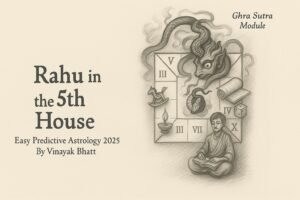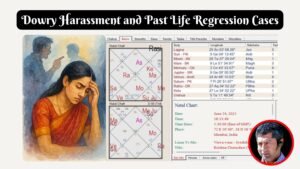Vimshottari Dasha – Logic By Krushana
Article By Krushana
[Pls note that this article is based on Krushna’s Ayanamsa – SA]
To find the timing of an event, we must know the period ruled by the significator planet. There are so many types of dasha systems, but I found the Vimshottari dasha most reliable. This system is based on the longitude of the Moon. The total Dasha period is 120 revolutions of the Sun. Shake is an Indian system of counting years and starts from the Chaitra Sukla paksha. The ancient sages discovered the life of a human being to be 120 years, and that is currently supported by scientists in the present day. By testing particular parts of the body, scientists have ascertained that it can work for 120 years and have thus concluded that the maximum life of a person can be up to 120 years. In astrology, these 120 years are comprised of the 12 signs and 27 constellations. Each Constellation is divided in four padas. Thus total 27X 4 = 108 padas and 12 signs make 120. This is the total of the Vimshottari dasha. The starting point is taken as longitude of the natal Sun in the birth chart. One year is one revolution of Sun in the zodiac. One month is equal to the time taken by the Sun in one sign, and one day is one degree of the Sun.
The total period of 120 years (120 revolutions of the Sun in the zodiac), has been allotted to 9 grahas. I will use the word “Graha” which is different than the word “planet”. “Planets” and “Stars” are the words used for heavenly bodies. Rahu and Ketu are grahas, but they are not planets. “Graha” means sources of energy and attraction and so it may be a distinction.
There are inner grahas and outer grahas. “Inner grahas” mean grahas between the Earth and the Sun, which includes the Sun, Mercury, Venus and the Moon. Ketu is also included in the inner grahas. Mars, Jupiter and Saturn are the outer grahas, and Rahu is treated as an outer graha as well. 120 years are divided in two equal parts of 60 years each and allotted to inner and outer grahas. There are 27 stars or constellations, names as 1 Ashvini, 2 Bharani, 3 Krittika, 4 Rohini, 5 Mrigrashira, 6 Ardra, 7 Punarvasu, 8 Pushya, 9 Ashlesha, 10 Magha, 11 Purvaphalguni, 12 Uttaraphalguni, 13 Hasta, 14 Chitra, 15 Swati, 16 Vishakha, 17 Anuradha, 18 Jyeshtha, 19 Mula, 20 Purvashadha, 21 Uttarashadha, 22 Shravan, 23 Dhanishta, 24 Satabisha, 25 Purva Bhadrapada, 26 Uttara Bhadrapada, and 27 Revati. The years to each planet is allotted considering the Sign and Constellations padas as per the friendship or uccha neech rashi. Each pada is referred to by sign names. For example, four padas of Ashvini with the first pada denoted by the first sign Aries, second as Taurus, third as Gemini and so on. This is the way that names of all 12 signs are given to each pada for first three stars. After that again it starts from Aries for first pada of Rohini. In this fashion all the 108 padas are given the names of signs.
The calculations begin from Revati, which is ruled by Mercury, Ashvini ruled by Ketu, Bharani ruled by Venus, Krittika by sun, Rohini by Moon. These are inner planets. By allotting 17 years to Mercury, 7 years to Ketu, 20 years to Venus, 6 years to Sun, and 10 years to Moon respectively, we arrive at a total of 60 years. The outer Grahas are then allotted, starting with Mrigrashira ruled by Mars, 7 years, Ardra ruled by Rahu 18 years, Punarvasu ruled by Jupiter 16 years, and Pushya ruled by Saturn 19 years, totaling another 60 years.
Each planet is allotted years, as per the uccha rashi or own rashi pada of the Nakshtra and the relation with the sign lord and karakatva. Those are as per following: Venus is allotted maximum years in the Vimshottari dasha as it is a friend to many signs lords and nakshtra lords. In Krittika there is 4, Rohini 2, Mrigrashira 3, Ardra 4, Punarvasu 2, Purva 3, Chitra 3, Swati 4, Mula 2, Purvashadha 3, Uttarashadha 4, Shravana 2, Dhanishta 3, Satabisha 4, Purva Bhadrapada 2, Uttara Bhadrapada 3, and Revati 4 and two years due to its two signs Taurus and Libra, Venus gets 20 years.
Next planet is the Sun and it gets a year in Ashvini 1, Punarvasu 1, Magha 1, Mula 1, Uttara Bhadrapada 1, and one year due to its Leo sign, total six years.
Next planet is the Moon, getting one year in Ashvini 4, Rohini 4, Punarvasu 4, Magha 2, Magha 4, Hasta 2, Hasta 4, Mula 4, Purva Bhadrapada 4, and one year due to Cancer sign total 10 years.
Next planet Mars gets one year each due to Purva Phalguni 4, Anuradha 4, Jyestha 2, Uttarashadha 2, Uttara bhadrapada 4, and 2 years due to signs (Aries and Scorpio) Total 7 years.
Rahu gets one year each due to Bharani 2, Bharani 4, Krittika 2, Krittika 3, Rohini 3, Mrigrashira 1, Ardra 2, Ardra 3 , Ashlesha 2, Ashlesha 3, Uttara 2, Uttara 3, Hasta 3, Chitra 2, Swati 2, Swati 3, Satabisha 2, Satabisha 3, a total of 18 years. (There is no sign owned by Rahu).
Jupiter gets one year from each Nakshtra pada as follows: Bharani 1, Krittika 1, Rohini 1, Pushya 1, Pushya 4, Ashlesha 1, Ashlesha 4, Purva 1, Uttara 1, Jyestha 1, Jyestha 4, Uttarashadha 1, Purvabhadrapada1, and Revati 1 and two years due to its own signs Sagittarius and Pisces for a total of 16 years.
Saturn gets dasha years as follows: Mrigrashira 1, Ardra 1, Punarvasu 3, Pushya 2, Pushya 3, Purva Phalguni 2, Vishakha 3, Anuradha 2, Anuradha 3, Jyestha 3, Purvashadha 4, Uttarashadha 3, Dhanishta 2, Satabisha 1, Purva Bhadrapada 3, Uttarabhadra 2, and Revati 3, and two years due to own sign, Capricorn and Aquarius. Total 19 years.
Mercury gets one year each from Ashvini 2 and Ashvini 3 , Bharani 3, Mrigrashira 4, Magha 3, Uttara Phalguni 4, Hasta 1, Chitra 1, Chitra 4, Swati 1, Vishakha 1, Purvashadha 2, Shravana 3, Dhanishta 4, and Revati 2 and two years due to own signs of Mercury. Total 17 years.
Remaining seven years are allotted to Ketu for remaining padas of Nakshtras. That is 7 years.
Thus total years allotted to each planet are given in following Table 1:
Table 1
| Planets | Mercury | Ketu | Venus | Sun | Moon | Mars | Rahu | Jupiter | Saturn | |
| Ashwini | ||||||||||
| Ashwini-1 Aries | 1 | |||||||||
| Ashwini-2 Taurus | 1 | |||||||||
| Ashwini-3 Gemini | 1 | |||||||||
| Ashwini-4 Cancer | 1 | |||||||||
| Aries | 1 | |||||||||
| Bharani | ||||||||||
| Bharani-1 Leo | 1 | |||||||||
| Bharani-2 Virgo | 1 | |||||||||
| Bharani-3 Libra | 1 | |||||||||
| Bharani-4 Scorpio | 1 | |||||||||
| Aries | ||||||||||
| Taurus | ||||||||||
| Krittika | ||||||||||
| Krittika-1 Sagittarius | 1 | |||||||||
| Krittika-2 Capricorn | 1 | |||||||||
| Krittika-3 Aquarius | 1 | |||||||||
| Krittika-4 Pisces | 1 | |||||||||
| Taurus | 1 | |||||||||
| Rohini | ||||||||||
| Rohini-1 Aries | 1 | |||||||||
| Rohini-2 Taurus | 1 | |||||||||
| Rohini-3 Gemini | 1 | |||||||||
| Rohini-4 Cancer | 1 | |||||||||
| Taurus | ||||||||||
| Gemini | ||||||||||
| Mrigashira | ||||||||||
| Mrigashira-1 Leo | 1 | |||||||||
| Mrigashira-2 Virgo | 1 | |||||||||
| Mrigashira-3 Libra | 1 | |||||||||
| Mrigashira-4 Scorpio | 1 | |||||||||
| Gemini | 1 | |||||||||
| Ardra | ||||||||||
| Ardra-1 Sagittarius | 1 | |||||||||
| Ardra-2 Capricorn | 1 | |||||||||
| Ardra-3 Aquarius | 1 | |||||||||
| Ardra-4 Pisces | 1 | |||||||||
| Gemini | ||||||||||
| Cancer | ||||||||||
| Punarvasu | ||||||||||
| Punarvasu-1 Aries | 1 | |||||||||
| Punarvasu-2 Taurus | 1 | |||||||||
| Punarvasu-3 Gemini | 1 | |||||||||
| Punarvasu-4 Cancer | 1 | |||||||||
| Cancer | ||||||||||
| Pushya | ||||||||||
| Pushya-1 Leo | 1 | |||||||||
| Pushya-2 Virgo | 1 | |||||||||
| Pushya-3 Libra | 1 | |||||||||
| Pushya-4 Scorpio | 1 | |||||||||
| Cancer | 1 | |||||||||
| Ashlesha | ||||||||||
| Ashlesha-1 Sagittarius | 1 | |||||||||
| Ashlesha-2 Capricorn | 1 | |||||||||
| Ashlesha-3 Aquarius | 1 | |||||||||
| Ashlesha-4 Pisces | 1 | |||||||||
| Leo | ||||||||||
| Magha | ||||||||||
| Magha-1 Aries | 1 | |||||||||
| Magha-2 Taurus | 1 | |||||||||
| Magha-3 Gemini | 1 | |||||||||
| Magha-4 Cancer | 1 | |||||||||
| Leo | 1 | |||||||||
| Purvapha | ||||||||||
| Purva-1 Leo | 1 | |||||||||
| Purva-2 Virgo | 1 | |||||||||
| Purva-3 Libra | 1 | |||||||||
| Purva-4 Scorpio | 1 | |||||||||
| Leo | ||||||||||
| Virgo | ||||||||||
| Uttarapha | ||||||||||
| Uttara-1 Sagittarius | 1 | |||||||||
| Uttara-2 Capricorn | 1 | |||||||||
| Uttara-3 Aquarius | 1 | |||||||||
| Uttara-4 Pisces | 1 | |||||||||
| Virgo | 1 | |||||||||
| Hasta | ||||||||||
| Hasta-1 Aries | 1 | |||||||||
| Hasta-2 Taurus | 1 | |||||||||
| Hasta-3 Gemini | 1 | |||||||||
| Hasta-4 Cancer | 1 | |||||||||
| Virgo | ||||||||||
| Libra | ||||||||||
| Chitra | ||||||||||
| Chitra-1 Leo | 1 | |||||||||
| Chitra-2 Virgo | 1 | |||||||||
| Chitra-3 Libra | 1 | |||||||||
| Chitra-4 Scorpio | 1 | |||||||||
| Libra | ||||||||||
| Planets | Mercury | Ketu | Venus | Sun | Moon | Mars | Rahu | Jupiter | Saturn | |
| Swati | ||||||||||
| Swati-1 Sagittarius | 1 | |||||||||
| Swati-2 Capricorn | 1 | |||||||||
| Swati-3 Aquarius | 1 | |||||||||
| Swati-4 Pisces | 1 | |||||||||
| Libra | 1 | |||||||||
| Scorpio | ||||||||||
| Vishakha | ||||||||||
| Vishakha-1 Aries | 1 | |||||||||
| Vishakha-2 Taurus | 1 | |||||||||
| Vishakha-3 Gemini | 1 | |||||||||
| Vishakha-4 Cancer | 1 | |||||||||
| Scorpio | ||||||||||
| Anuradha | ||||||||||
| Anuradha-1 Leo | 1 | |||||||||
| Anuradha-2 Virgo | 1 | |||||||||
| Anuradha-3 Libra | 1 | |||||||||
| Anuradha-4 Scorpio | 1 | |||||||||
| Scorpio | 1 | |||||||||
| Jyeshta | ||||||||||
| Jyeshta-1 Sagittarius | 1 | |||||||||
| Jyeshta-2 Capricorn | 1 | |||||||||
| Jyeshta-3 Aquarius | 1 | |||||||||
| Jyeshta-4 Pisces | 1 | |||||||||
| Sagittarius | ||||||||||
| Mula | ||||||||||
| Mula-1 Aries | 1 | |||||||||
| Mula-2 Taurus | 1 | |||||||||
| Mula-3 Gemini | 1 | |||||||||
| Mula-4 Cancer | 1 | |||||||||
| Sagittarius | 1 | |||||||||
| Purvashada | ||||||||||
| Purvashada-1 Leo | 1 | |||||||||
| Purvashada-2 Virgo | 1 | |||||||||
| Purvashada-3 Libra | 1 | |||||||||
| Purvashada-4 Scorpio | 1 | |||||||||
| Sagittarius | ||||||||||
| Capricorn | ||||||||||
| Uttarashada | ||||||||||
| Uttarashada-1 Sagittarius | 1 | |||||||||
| Uttarashada-2 Capricorn | 1 | |||||||||
| Uttarashada-3 Aquarius | 1 | |||||||||
| Uttarashada-4 Pisces | 1 | |||||||||
| Capricorn | ||||||||||
| Shravana | ||||||||||
| Shravana-1 Aries | 1 | |||||||||
| Shravana-2 Taurus | 1 | |||||||||
| Shravana-3 Gemini | 1 | |||||||||
| Shravana-4 Cancer | 1 | |||||||||
| Capricorn | 1 | |||||||||
| Aquarius | ||||||||||
| Dhanishta | ||||||||||
| Dhanishta-1 Leo | 1 | |||||||||
| Dhanishta-2 Virgo | 1 | |||||||||
| Dhanishta-3 Libra | 1 | |||||||||
| Dhanishta-4 Scorpio | 1 | |||||||||
| Aquarius | 1 | |||||||||
| Satabisha | ||||||||||
| Satabisha-1 Sagittarius | 1 | |||||||||
| Satabisha-2 Capricorn | 1 | |||||||||
| Satabisha-3 Aquarius | 1 | |||||||||
| Satabisha-4 Pisces | 1 | |||||||||
| Aquarius | ||||||||||
| Pisces | ||||||||||
| Purvabhadra | ||||||||||
| Purvabhadra-1 Aries | 1 | |||||||||
| Purvabhadra-2 Taurus | 1 | |||||||||
| Purvabhadra-3 Gemini | 1 | |||||||||
| Purvabhadra-4 Cancer | 1 | |||||||||
| Pisces | 1 | |||||||||
| Uttarabhadra | ||||||||||
| Uttarabhadra-1 Leo | 1 | |||||||||
| Uttarabhadra-2 Virgo | 1 | |||||||||
| Uttarabhadra-3 Libra | 1 | |||||||||
| Uttarabhadra-4 Scorpio | 1 | |||||||||
| Pisces | ||||||||||
| Revati | ||||||||||
| Revati-1 Sagittarius | 1 | |||||||||
| Revati-2 Capricorn | 1 | |||||||||
| Revati-3 Aquarius | 1 | |||||||||
| Revati-4 Pisces | 1 | |||||||||
| Total | 17 | 7 | 20 | 6 | 10 | 7 | 18 | 16 | 19 | 120 |
Table 2
| INNER GRAHAS | |
| Mercury | 17 years |
| Ketu | 7 years |
| Venus | 20 years |
| Sun | 6 years |
| Moon | 10 years |
| TOTAL YEARS | 60 |
| OUTER GRAHAS | |
| Mars | 7 years |
| Rahu | 18 years |
| Jupiter | 16 years |
| Saturn | 19 years |
| TOTAL YEARS | 60 |
The periods, as shown in Table 2, are known as Mahadasha (Main Periods). It is further sub divided into nine sub-periods. The division for each of these sub-period planets is in proportion to its Mahadasha period. The first division is always that of the Mahadasha Lord. The sub period can be found from the following formula:
Let M = Mahadasha period
Let S = the sub lord of the Mahadasha period
Let s = result of sub period in decimal years, which can be converted into sign and degree of the Sun.
The formula now becomes: s=M X S divided by 120
For example, we want to find the sub period of Mercury in the Main period of Saturn.
If we look at the table in Table 2, we can see that Saturn (M) = 19 years and Mercury (S) = 17 years.
s = M X S divided by 120
s = 19 X 17 divided by 120
s = 2.6916666
This converts into 2 years, 8 signs and 9 degrees. In this period, Sun makes two rounds of the Zodiac and 8 signs and 9 degrees in next sign.
- However, there is an easier way to do this by dividing the original formula by 10 instead of 12. This will automatically give you the number of signs. This means number of signs, the Sun travels. Let’s see.
Number of signs = M X S divided by 10
Number of signs = 19 X 17 divided by 10
Number of signs = 32.3
The 32.3, means 32 signs and .3 of a sign = 3 X 3 = 9 degrees. This means in this period the Sun will travel 32 signs and 9 degrees.
We can now see that 32 signs = 2 years (revolutions of Sun) and 8 signs (plus the 9 days), which comes to the same thing as the first formula where we divided by 12.
- This can be done orally also, but we must know the Mahadasha period first.
For example, let’s take Rahu. If we want to take the sub period of Rahu in the Mahadasha period of Rahu, we will have this:
RAHU Mahadasha = 18
Rahu Sub-period = 18
Total = 324 (leave out the 4)
Leave out the last digit, which is 4, so that the remainder is 32. These are the number of signs, which then converts to 2 years (two revolutions of the Sun) and 8 signs.
Now multiply the last digit of the number 324 by 3. (4X3) it gives 12 degrees. Therefore, the sub-period of Rahu in the Rahu Mahadasha = 2 revolutions 8 signs, 12 degrees. If this is converted to sun’s transit it will be two rounds of zodiac and 8 signs and 12 degrees.
- Mars sub in Mars main = 7X7 = 49 = four signs and 27 degrees of Sun.
(49 ¸ 10 = 4.9, which is equals to 4 signs and 27 (9 X 3) degrees.)
- Sun sub in Moon main = 6 X 10 = 60 = six signs and 0 degree.
From the above equation one can find the sub period of any planet.
- Now suppose the main period of Venus starts from the 1st of January, 1980. It lasts for 20 years. Now suppose we have to find the sub period of Mars in Venus main.
Add the total years of Venus + Sun + Moon up to Mars = 20 + 6+ 10 = 36.
Now we have to find the start of the Mars sub period. So we multiply 36 by 20 (the main period of Venus) 36 X 20 = 720 leaving out the last digit, which gives us 72 (signs) = 6 years. The last digit of 720 stands for degrees which give us zero degree.
This means that the Mars sub period in Venus Mahadasha will start after 6 revolutions of the Sun from 1st Jan, 1980. This means that the Sun will reach, after six complete revolutions, the same sign and degree which it was on 1st Jan 1980. This may come to 1st Jan, 1986 approximately. The Mars sub-period in Venus Mahadasha will be 7 X 20 = 140 = 14 signs and zero degree. That is one complete revolution and 2 signs. This means the Mars sub-period will end when the Sun completes one revolution and two signs ahead in the same degree as it was on 1st Jan 1986.
Similarly, we can find the sub period of any planet in the Main or Mahadasha period of any planet.
The calculation of the Vimshottari dasha is based on the Suns longitude in the birth chart. The years of a dasha are a complete revolution of the Sun, with the month being the sign and the days the degrees of Sun. The balance of the dasha at the time of birth is added to the natal Sun. Thus the end of the dasha will be on the day when Sun will reach the same sign and degree after a complete revolution equal to the years.
Example:
Birth data 23rd Jun 1972 at time 6:40 am and Sun rise was 6:23 at the birth place. This means Native was born 17 minutes after the Sunrise. These are 42 Pals and 30 vipals after Sunrise.
Hence if we cast the chart we get natal longitude of Sun as 9: Ge: 5minutes and 55.83 seconds and Moon at 27degrees: Lib: 26 minutes: 47.55 seconds.
This means the Moon is in Libra 27 degrees and 26 Minutes, and 47.55 seconds. Moon is in the nakshtra of Vishakha ruled by Jupiter. The Vishakha starts from 20 degree 00 minutes in Libra. This means Moon has passed 7 degree and 26 Minutes and 47.55 seconds of Vishakha. Total Mahadasha of Jupiter is passed proportion to passed degree of Moon in Vishakha. This means 446.7925 minutes out of 800 minutes of Vishakha. Hence 8.93585 years passed, which is equal to 8 years, 11 months and 6 day and 54 Ghatis 21.6 Pals. Hence 7.06414 years is balance, which is equal to 7 years 0 months 23 days, 15 hours, 44 minutes and 53 seconds. This means on the day of birth and at birth time 7 years, 0 months 23 days, 15 hours, 44 minutes and 53 seconds are balance of Jupiter Mahadasha. Now to find the date when Jupiter Mahadasha ends we must find the transit revolutions Signs and degrees of Sun in the above period (balance dasha period). Adding this figure in tropical Sun at the time of Birth will give the Sun’s Tropical latitude when Jupiter Mahadasha will end. This tropical latitude of Sun will be same for all the ends of other Mahadasha. (All the Mahadasha are in full figure of year hence full revolutions of Sun.)
In above time period Sun will make 7 revolutions and move ahead by 21 degrees, 53 minutes and 43.72 seconds. Hence Jupiter Mahadasha will end when Sun will complete 7 revolutions of the zodiac and pass zero signs, 21 degree, 53 minutes and 43.72 seconds ahead of Tropical Sun at the time of birth. Adding this to tropical sun at the time of Birth:
3 signs 01 degrees 40 Minutes and 51.83 second
0 sign 21 Degrees 53 Minutes and 43.72 seconds
3 Signs 23 degrees 34 Minutes and 35.55 seconds
Hence after 7 revolutions when tropical Sun will reach 23 degrees of Cancer 34 minutes and 35.55 seconds, Jupiter Mahadasha will end, and next Mahadasha of Saturn will start. Saturn Mahadasha will end after 19 complete revolutions of tropical Sun and when it reaches the same degrees as stated above. Following table will give the starting date and time of each Mahadasha and end of the Mahadasha and the tropical degree of Sun on ending date. In other words the Mahadasha ends when the tropical sun reaches to the longitude shown in last column of the table in the year given.
On the end dates and time of each Mahadasha the tropical Sun will be in Cancer sign 23 degrees, 34 minutes and 35.55 seconds.
| TABLE SHOWING MAHADASHA WITH TROPICAL SUN | ||||||||
| Mahadasha | Start | To | When Tropical Sun is at | |||||
| Jupiter | 1963-Jul-17 01:36:32 | 1979-Jul-16 22:24:53 | 3:23:34:35.55 | |||||
| Saturn | 1979-Jul-16 22:24:53 | 1998-Jul-16 12:24:47 | 3:23:34:35.55 | |||||
| Mercury | 1998-Jul-16 12:24:47 | 2015-Jul-16 14:58:39 | 3:23:34:35.55 | |||||
| Ketu | 2015-Jul-16 14:58:39 | 2022-Jul-16 07:23:16 | 3:23:34:35.55 | |||||
| Venus | 2022-Jul-16 07:23:16 | 2042-Jul-16 03:23:24 | 3:23:34:35.55 | |||||
| Sun | 2042-Jul-16 03:23:24 | 2048-Jul-15 14:08:16 | 3:23:34:35.55 | |||||
| Moon | 2048-Jul-15 14:08:16 | 2058-Jul-16 00:01:50 | 3:23:34:35.55 | |||||
| Mars | 2058-Jul-16 00:01:50 | 2065-Jul-15 16:36:57 | 3:23:34:35.55 | |||||
| Rahu | 2065-Jul-15 16:36:57 | 2083-Jul-16 00:46:49 | 3:23:34:35.55 | |||||
|
|
||||||||
| TABLE SHOWING MAHADASHA WITH NIRAYAN SUN | ||||||||
| Mahadasa | Start | To | When Nirayan Sun is at following degrees | |||||
| Jupiter | 1963-Jul-17 01:36:32 | 1979-Jul-16 22:24:53 | 3:00:53:40.55 | |||||
| Saturn | 1979-Jul-16 22:24:53 | 1998-Jul-16 12:24:47 | 3:00:37:32.21 | |||||
| Mercury | 1998-Jul-16 12:24:47 | 2015-Jul-16 14:58:39 | 3:00:23:05.26 | |||||
| Ketu | 2015-Jul-16 14:58:39 | 2022-Jul-16 07:23:16 | 3:00:17:08.97 | |||||
| Venus | 2022-Jul-16 07:23:16 | 2042-Jul-16 03:23:24 | 3:00:00:08.56 | |||||
| Sun | 2042-Jul-16 03:23:24 | 2048-Jul-15 14:08:16 | 2:29:55:02.75 | |||||
| Moon | 2048-Jul-15 14:08:16 | 2058-Jul-16 00:01:50 | 2:29:46:32.74 | |||||
| Mars | 2058-Jul-16 00:01:50 | 2065-Jul-15 16:36:57 | 2:29:40:36.22 | |||||
| Rahu | 2065-Jul-15 16:36:57 | 2083-Jul-16 00:46:49 | 2:29:25:17.52 | |||||
Table
| Mahadasa | Start | To |
| Jupiter | 1963-Jul-17 | 1979-Jul-17 |
| Saturn | 1979-Jul-17 | 1998-Jul-16 |
| Mercury | 1998-Jul-16 | 2015-Jul-16 |
| Ketu | 2015-Jul-16 | 2022-Jul-16 |
| Venus | 2022-Jul-16 | 2042-Jul-16 |
| Sun | 2042-Jul-16 | 2048-Jul-16 |
| Moon | 2048-Jul-16 | 2058-Jul-16 |
| Mars | 2058-Jul-16 | 2065-Jul-16 |
| Rahu | 2065-Jul-16 | 2083-Jul-16 |
Scanned copies of the old charts is given below to show the method how Vishontary dasha was written with reference to longitude of Sun.
Old Chart Showing How To Write Dasha Table


The Dasha system time period is based on the Sun’s transit. To find the date when the Sun will be in a particular sign and degree needs astronomical calculations. To make this easy we can use the Christian calendar by which we get a period within a few days difference that is within acceptable limits.
About Author : Krushnaji is one of the most popular names on the net for bringing out a system of Ashtakvarga (KAS) contrary to what we know of Ashtakvarga. His Guru’s system, which he has painstakingly taught free of cost to members throughout the world, is in the Yahoo group ‘astrology and timing.’ It has become extremely popular due to its accurate method of timing events. Krushnaji was born in 1943. Following his dharma, he started a school for mentally retarded children.











Leave a reply
You must be logged in to post a comment.